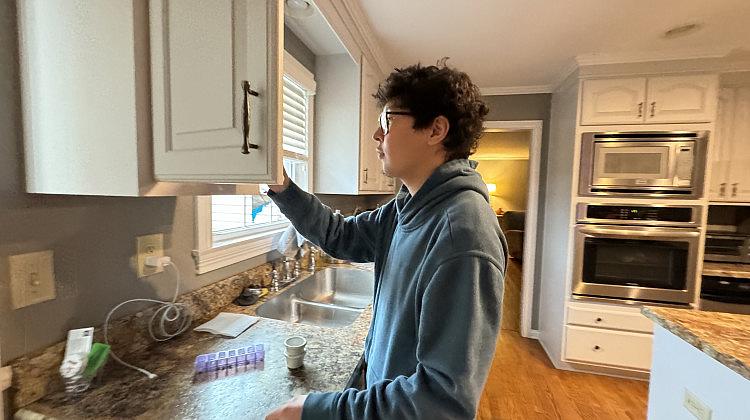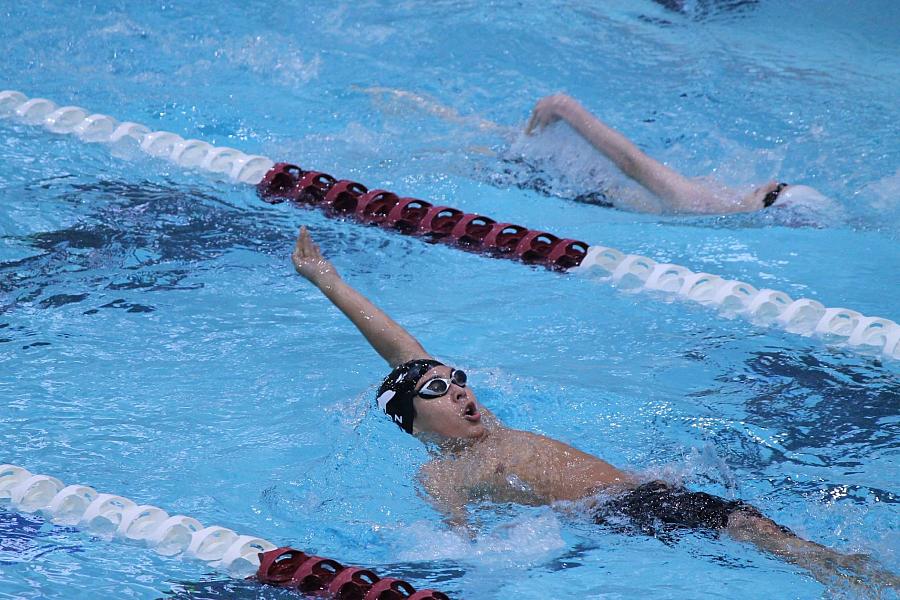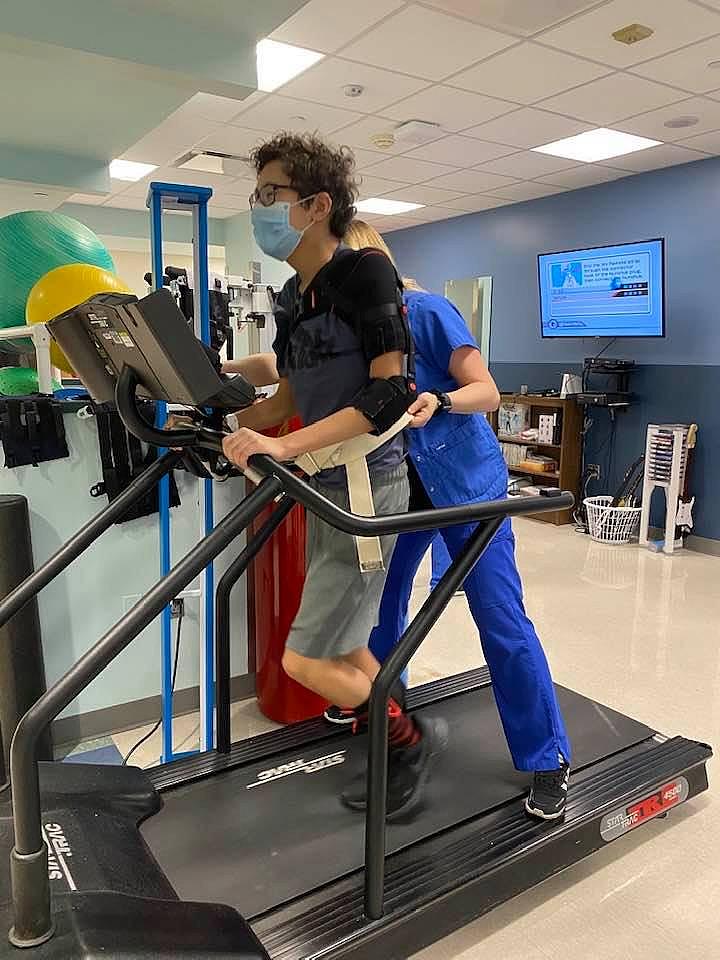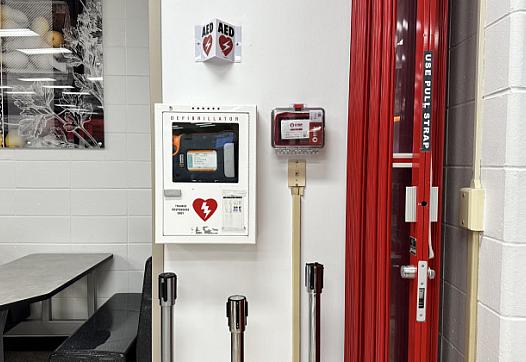Here’s what happens to the 11% of kids who survive cardiac arrest
The story was originally published by WFYI with support from our 2023 Data Fellowship.

Zane Hendrickson takes about nine pills in the morning and two at night. Some of these are medications hell be on for the rest of his life.
Elizabeth Gabriel / Side Effects Public Media
Lauren Abbott remembers her nearly two year-old son, Lucas Abbott, grabbing onto her as she patted his back to help him cough up food at their house in Carmel, Ind in 2017.
She thought he was choking. But then, he started turning blue and stopped breathing. He started going into his first of many sudden cardiac arrests.
A sudden cardiac arrest is when someone’s heart stops pumping blood and the person is no longer conscious or breathing.
Lucas was diagnosed with ventricular tachycardia in his lower left ventricle due to an extremely rare, undetectable arrhythmia. It causes the heart to beat faster and prevents the heart chambers from filling with blood, which led to his cardiac arrest.
“He lost all speech, he couldn't even sit up anymore. It was like his body went back to being like a baby,” Abbott said.
A sudden cardiac arrest can happen to children who seem healthy if they have an undiagnosed heart condition. If it happens, around 11% of kids survive it, often facing an uphill battle to recovery.
Only 8% of sudden cardiac arrest survivors recover without neurological deficits. The degree of damage depends on several factors, including how quickly resuscitation occurred. Sudden cardiac arrest victims who go four to six minutes without CPR are more likely to have some degree of brain damage. While those who go 10 minutes or more without resuscitation could sustain brain death.
Lauren and her family quickly did CPR when her son’s heart stopped. That’s one of the reasons he’s still alive, and recovering.
Lauren said it felt like they were constantly living at the hospital while Lucas was admitted for two and a half months, plus additional years of therapy. It wasn’t until three months later that Lucas was able to walk on his own again and feed himself. It took another six to eight months for him to be able to use the stairs, but he couldn’t always use them quickly or without handrails.
If someone were to look at him now, they would probably have no idea anything ever happened, Lauren said. But the side effects from his sudden cardiac arrests continue to show up in other ways.
Lucas is now 8 years old. He can do physical things, like sparring during taekwondo practice, but he has trouble retaining reading and math skills.
“He knows all of his letters, he knows his numbers,” Abbott said. “He’s able to do his addition facts and subtraction facts, he can read — there are days where he's reading really well. But then there are some days, it's like, he forgot everything that we just did and there's nothing there for him to build on.”
Research shows that a quarter of kids who survive cardiac arrest suffer from cognitive impairments.
“Initially, you may have some delayed milestones, but then with therapy, things look pretty good,” said Lisa Mcguire, pediatric neurologist with Ascension St. Vincent Hospital. “And then you get into school. And you really start to see problems with social interaction, you can see problems with learning, you see problems with focus and attention and behavior, even.”
Mcguire, who’s worked with Lucas for the past seven years, has recommended he play certain games to help with his response time and memory. She thinks he will continue to get better.
Bodily damage to survivors
Between 300,000 and 400,000 people in the United States have a sudden cardiac arrest every year –– that’s around double the number of people living in Kansas City, Kan. Among them, around 20,000 are children.
Besides the cognitive and physical damage, research shows there can be high rates of psychological distress among survivors of out-of-hospital sudden cardiac arrests. Rates of depression range from 14% to 45%, anxiety rates are between 13% and 61% and post-traumatic stress disorder rates run from 19% to 27%.
Some people say that sudden cardiac arrests are rare. Recently, though, awareness has increased, especially after high profile incidents involving young, seemingly healthy athletes.

Christa Hendrickson / Submitted photo
Zane Hendrickson couldn’t catch his breath after doing laps during swimming practice. He started having abdominal pain, so his friend drove him 30 minutes from Boonville, Ind. to the nearest hospital in Evansville. He went into sudden cardiac arrest there in 2021.
“I obviously didn't think that it was a possibility for me,” Zane said. “I'd gone my whole life [with] barely any illnesses. The worst thing that ever happened to me was I chipped my tooth.”
Hendrickson eventually had a seizure and went into a coma for about two weeks. His cardiac arrest was caused by an undetected birth defect that impacted his coronary arteries, similar to when a garden hose is twisted and water doesn't come out.
About 1 in 50,000 to 1 in 80,000 young athletes die of sudden cardiac arrest each year, making it the leading cause of death in young athletes. For context, the incidence of sudden cardiac arrest deaths in the general population is 1 in 1,000.
After the cardiac arrest, Hendrickson had open heart surgery and later got an implantable cardioverter defibrillator (ICD), which shocks him if his heartbeat becomes irregular. He was hospitalized for roughly three months so he could relearn how to walk and talk. Now, he can only type with one hand, and his left arm may never regain full function.
He is adjusting to his new normal, and has even gone back to swimming recreationally, but navigating his new medical needs can be overwhelming sometimes, he said.

Christa Hendrickson / Submitted photo
Survival chances and what comes next
Sudden cardiac arrests are unexpected but there are ways to be prepared to respond if and when it happens. Learning how to immediately perform CPR and making sure an automated external defibrillator (AED) is quickly accessible can dramatically improve outcomes.
Jacob Mikeworth of Monrovia, Ind. collapsed and went into sudden cardiac arrest in 2022 during choir practice at his high school just three days after his 17th birthday.
“I kind of got really tired all of a sudden. I couldn't really get any words out. There was no breath, no nothing. And so I just kept looking at my friend and fell,” he said.
Luckily, his friend caught him before Jacob’s head hit the metal bleachers, and someone eventually used an automated external defibrillator to shock his heart and help keep him alive. Survival rates in youth increase to 61–87% if someone uses an AED within the first few minutes and the victim has a shockable rhythm. For every minute of delay, survival chances fall by up to 10%.
Jacob was diagnosed with ventricular fibrillation, a malfunction of the normal beating rhythm of the lower chambers of the heart. He stayed in the hospital for about a week. He’s since had a pacemaker implanted, which shocks him if his heart rate drops too low. But doctors told him he’ll probably be on heart medication for the rest of his life.
Now he’s finishing up his senior year of high school, but not without some hurdles –– some showing up two years after the cardiac arrest.
Jacob said his heart medication has made his eyes sensitive to light, which can cause migraines. He sometimes wears sunglasses indoors to help, but he said some teachers don’t think he needs them.
“They do allow me to wear sunglasses,” Jacob said, “but I still do have some teachers that are like, ‘oh, you shouldn’t be having to wear those sunglasses,’ and try to push that, ‘oh, you're fine. Look at your age, you're so well.’”
Recently, he’s started to feel weak, have blurry vision, and joint pain. Now his mother, Amy Mikeworth, said those medical issues may have been caused by his cardiac arrest, but could also be related to his nervous system
“We just know that he's having continued issues and the cardiologist doesn't think it has anything to do with the heart,” Amy said. “So we're trying to figure it out.”
Amy said they need to see a neurologist, but she said it could be up to six months until he’s able to see one. These long wait times are not uncommon.
“Getting things like neuropsych testing, which is what kind of quantifies issues after brain injury, whether it's from arrest or from concussion, you actually can't get it,” pediatric neurologist Mcguire said. “I would say it’s almost a crisis to be honest.”
Even if someone is able to schedule an appointment, Mcguire said, it could be a struggle to get neuro psych tests covered by insurance.


